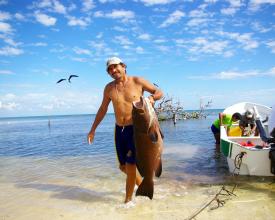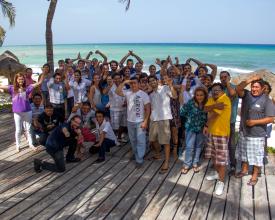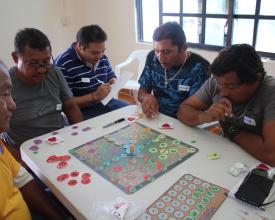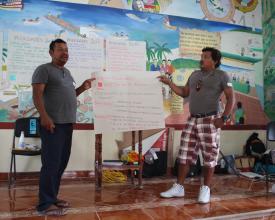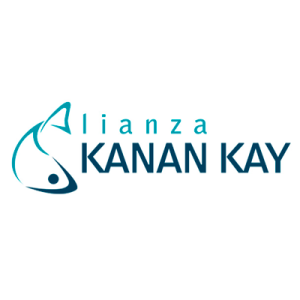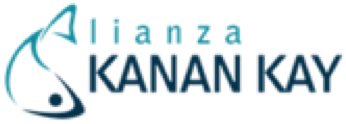
Collective Impact: Fisheries and Inter-Sectoral Collaboration
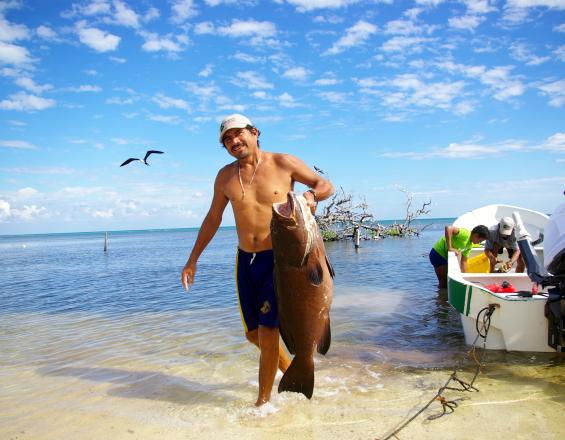
Quintana Roo (Mexico) has a high marine productivity, but over-fishing and coastal development are leading to a decline of key ecosystems due to pollution and habitat loss. Climate Change is an additional stress factor to this already impacted environment. Lack of artisanal fishermen’s participation in fisheries management has resulted in unsustainable species extraction. To enable change and facilitate collaboration for conservation, the Kanan Kay Alliance was founded as an inter-sectorial coalition promoting shared responsIbility through collective action. Its goal is to protect 20% of the territorial sea through a network of fish refuges; fostering fishermen's participation in fisheries management.
Context
Challenges addressed
Environmental:
- Overexploitation of fished stocks.
- Lack of effective adaptive management tools, especially in the face of climate change.
- No-take fishing zones are still low in coverage.
- Need for sustained protection in time, and bigger surfaces, in order to understand and evaluate all ecological impacts.
- Lack of effective connectivity between no-take zones.
Social:
- Poor enforcement poses the major threat not only for biodiversity replenishment, but also hindering social acceptance and support for this fisheries management tool.
- Fish refuges are a fairly new strategy in Mexico, given that the first no-take areas have just been renewed for the first time at national level and are no more than 5 years old. This generates uncertainty about the mechanisms of participation of the fishing sector in the definition of public policies.
Economic:
- Need to evaluate ecosystem services and asses environmental value.
- Need to improve tools for understanding and implementing blue economy solutions.
Location
Process
Summary of the process
Theory of change based on the steps needed to foster collective impact:
- Empowerment of fishermen. A comprehensive diagnosis on the socio-economic situation of the fishing organizations needs to be conducted prior to start working with coastal communities. This includes a gap-analysis and finally, capacity-building is provided.
- Once the socioeconomic universe is understood, inter-sectorial collaboration is fostered by the backbone organization (Kanan Kay Alliance) and follow-up is conducted.
- It is time for on-the-field work. It is crucial to achieve specific and tangible results at early stages so that the momentum and motivation for change is maintained. In the Alliance, we choose to do that by implementing a specific fisheries management tool (fish refuges).
- Financial compensation needs to be addressed to prove that conservation efforts are not confronted to sustainable economic growth. Fishermen participate the scientific monitoring during the closed fishing season and receive a compensation for that.
- It is crucial to have a strong legal and institutional framework so that lack of enforcement doesn’t hinder the overall performance of the initiative.
Building Blocks
Empowerment of fishermen
In order to start a capacity building strategy, a diagnosis of the fishing organization is first conducted. Fishermen are trained in different topics such as leadership skills, scientific monitoring, community surveillance, administration of fishing organizations, human development. Training is provided by members of the Alliance, such as civil society organizations, other fishermen, academia and governmental agencies.
Enabling factors
- Ownership and responsibility for the initiative by the fishermen
- Active participation by fishermen
- Strong leadership
- Institutions with capacities and will to support fishermen
Lesson learned
By bringing together social, environmental and economic topics for the trainings and not focusing solely on resource management related workshops, we have been able to increase collective impact and sustain it over time. Strengthening the three key aspects to sustainability has been fundamental. We’ve learned that our best strategy is that which provides leadership skills, human development, personal and organizational administration, business plans for fishing cooperatives or fair trade. Fishermen need to be asked and coached to find out their own weaknesses and strengths. Time and resources must be invested to include customers into the fishermen’s projects.
Design and implementation of fish refuges
Based on a participatory bottom-up process, an effective, legally recognized and locally respected network of fish refuges is established. Sixteen fish refuges have been created since 2012, covering more than 18000 hectares.
Enabling factors
- Willingness of fishing organizations to improve sustainable practices and ensure fisheries for future generations.
- Clear common goal.
- Participative processes for designing fish refuges.
- Combination of scientific and local-ecological knowledge.
- Temporary scope of the fish refuges increases confidence of fishermen in the process and allows for adaptive management.
- Final decision to create fish refuges relies solely on fishing organizations.
- Support from collaborative network.
Lesson learned
The local-ecological knowledge that fishermen provide about natural resources, fishing grounds and climate conditions, are fundamental elements to be considered in the design of a fish refuge. When combining local-ecological knowledge with scientific knowledge it is important that a transparent negotiation begins that will enable to have the best science-based conditions with social acceptance.
Then, a community monitoring program is led by organizations members of the Kanan Kay Alliance. Fishermen and women are trained and actively participate in collecting data. Hence, they see results with their own eyes and can then share the information with other members of the community. Once monitoring results have been delivered, during the renewal process, the goals of the fish refuges are reviewed to understand if they meet biophysical criteria for no-take zones and hence, if changes need to be done.
This “bottom-up” approach must be complemented with “top-down” elements to ensure that decision-making reflects the complexity of this process.
Inter-sectorial collaboration
The Alliance unites a diverse group of stakeholders and serves as a dialogue board and facilitates the exchange of ideas, capacities and experiences, generating synergies and mutually beneficial solutions.
Enabling factors
- Common agenda. Allows to be clear and transparent about the main objective of the initiative.
- Shared measurement. A set of indicators needs to be established to measure progress.
- Foster mutually reinforcing activities. Through strong coordination.
- Continuous communications. Trust is key; we build honest relationships between members.
- Backbone organization. The Kanan Kay Alliance has a coordinating committee represented by members and dedicated to implement, coordinate and follow-up on the activities adding for collective impact.
Lesson learned
Working together as a collective impact platform doesn’t mean that we do everything all together at all times. It is about how to boost the best of every organization, while respecting and understanding the strengths and opportunity areas. Communities must have a clear role in the decision-making, which brings us back to building block #1 about empowering fishermen and building capacities.
Financial compensation
A combination of public and private funds helps to partially compensate fishermen for their participation in, e.g. biological monitoring activities or general assemblies.
Enabling factors
- Budget covers essential expenses so fishermen can participate in different activities.
- Fish refuges are resemble a bank saving mechanism that will ensure the fishing activity itself for future generations.
- Fish refuges also benefit the fisheries in the mid-term due to biomass spill-over effect.
- Willingness of fishermen to participate and lead efforts.
- Organizations have the will and capacity to share trainings to members of the alliance.
- Communication: appropriate language to create common understanding.
Lesson learned
Having leadership and ownership of the fishermen in the Alliance strengthens and helps the initiative. The institutional actors, academics and civil society organizations support collective action based on community empowerment in a way they did not do before, because they respect one basic premise: if the fishermen do not agree to and support the actions, the implementation would not be possible. This approach additionally allows for a more direct communication, an implementation of basic principles of collaboration and a growing trust between the participants.
Legal and institutional framework
The existing legal framework for the formation of fish refuges is analyzed and reviewed. Tools for participatory managed fish refuges are identified, as well as for inspection and surveillance activities.
Enabling factors
- Clear identification of legal tools available, requirements and procedures for implementation.
- Persistence in the administrative and political processes.
- Socialization of legal framework with fishermen (workshops, meetings and informal discussion).
- Community surveillance workshops for fishing organizations are opportunities to build trustful relationships.
- Gap analysis of the legal system.
- Coordination with the different institutions.
- Development complementary norms to strengthen legal framework.
- Budget for implementation.
Lesson learned
Using fishing tools in protected areas was an important challenge in the Mexican Caribbean, and not always well received by the authorities in charge of the protected areas. Nevertheless, due to the technical and legal arguments, the first fish refuges zones were legally established in two biosphere reserves in 2012. This was supported by the intensive work together with the fishermen, several years before the Alliance existed. But when talking about legal and institutional framework, it is not enough to have a bottom-up participatory approach. Some legal changes require high-level work within the public administration. Efforts must be made in balancing both approaches. The Kanan Kay Alliance allowed to combine the bottom-up style with the more top-down approach from the public institutions, providing the arena for the discussion and building on a common goal.
Impacts
- A network of 16 fish refuges that protect more than 18,000 hectares of coral reefs, seagrass meadows and coastal wetlands has been established since 2012.
- The first generation of fish refuges (no-take fishing areas) has been renewed for a period of five more years, as an initiative of the fishermen.
- Fishermen conduct scientific monitoring, community surveillance, participate in capacity-building workshops and are key stakeholders in the decision-making.
- The Kanan Kay Alliance has been active for more than five years as a collaborative network promoting the agreement upon a common agenda, establishing shared measurements, fostering cross-collaboration
The Kanan Kay Alliance is a voluntary member-based initiative that aims to act as the backbone organization to achieve collective impact. It involves around 40 members from the government, fishing cooperatives, civil society organizations, academic researchers and private donors. Work is being done to improve governance whilst strengthening the role of the fishing organizations in this network.
Beneficiaries
- Fishing organizations
- Civil society organizations
- Local, regional and national government
- Academia (researchers)
- Private initiative: Tourism sector (diving, recreational fishing) and local businesses (fish and seafood shops)
Sustainable Development Goals
Story
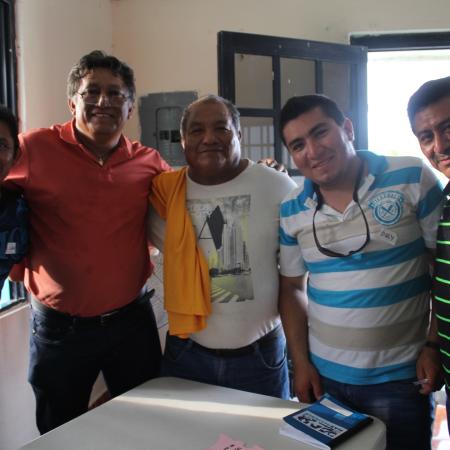
At one General Assembly, Kanan Kay Alliance members discussed which terminology to use when referring to “fish refuges” as opposed to "no-take zones". For some governmental representatives, changing to a different term that was both technically correct and easy to understand made a lot of sense. For the fishermen, however, changing the term would have been synonymous with betraying the overall goal of the Alliance. The discussion reached a point where the fishermen were prepared to exercise their power of veto and leave the assembly if the term were to be changed. In the end, the Alliance decided to keep the term, as it was of great importance to the fishermen. This incident helped increase the fishermen´s confidence in a joint management approach and its successful implementation. The fishermen realized that members were equal partners, all committed to the same mission of developing responsible fisheries.
